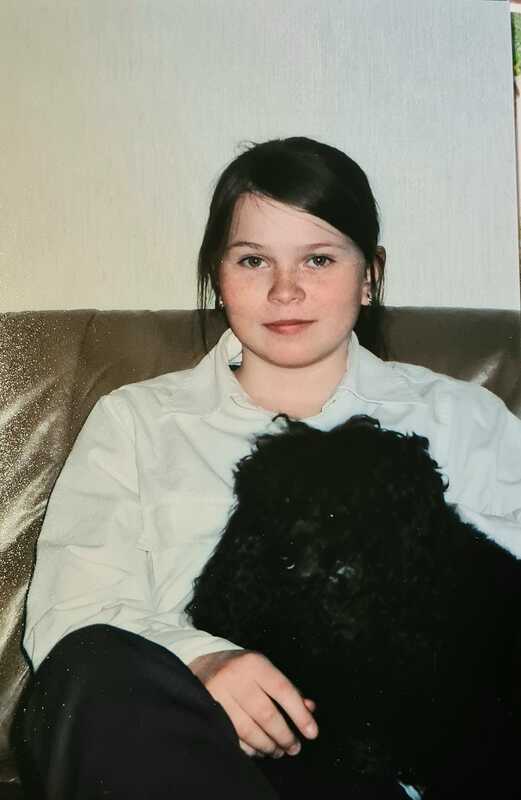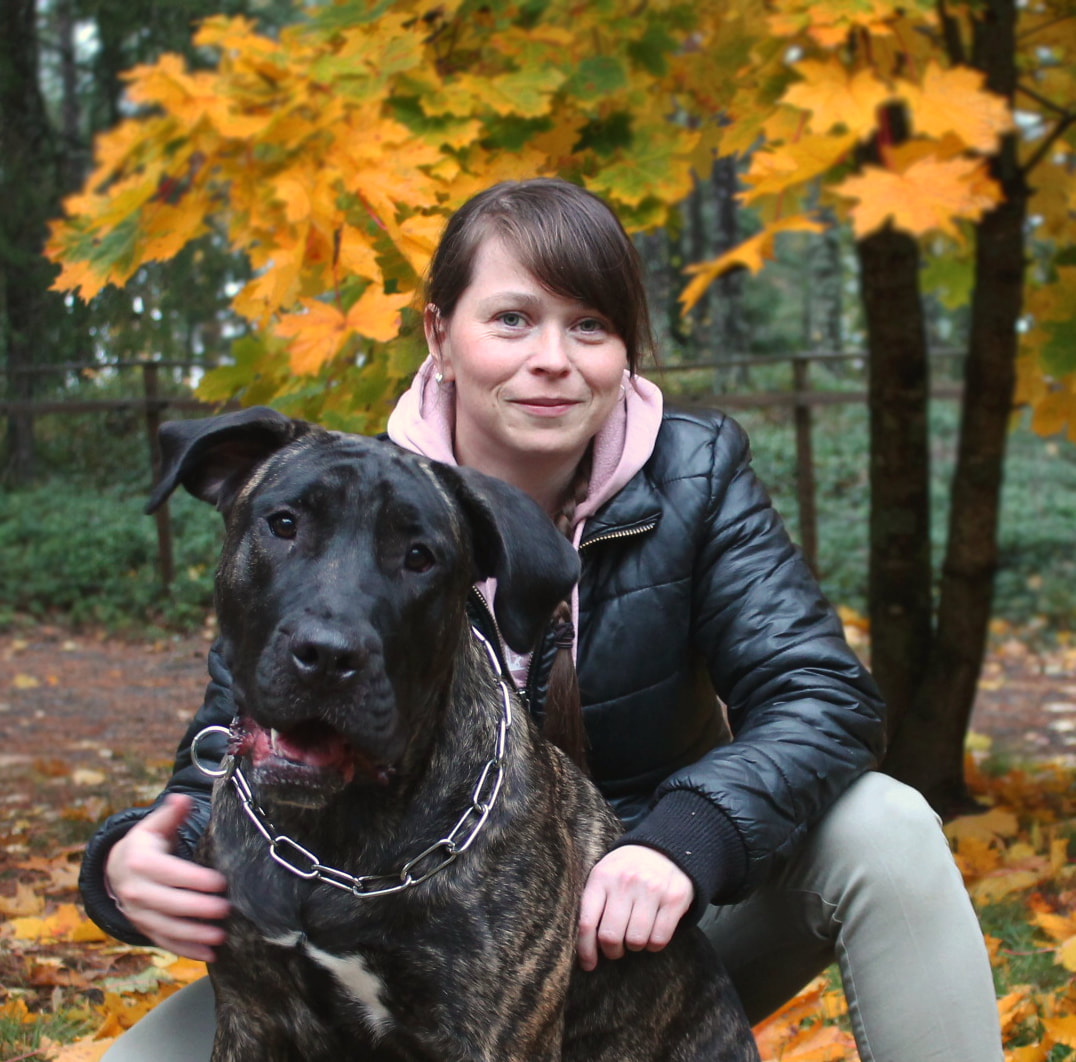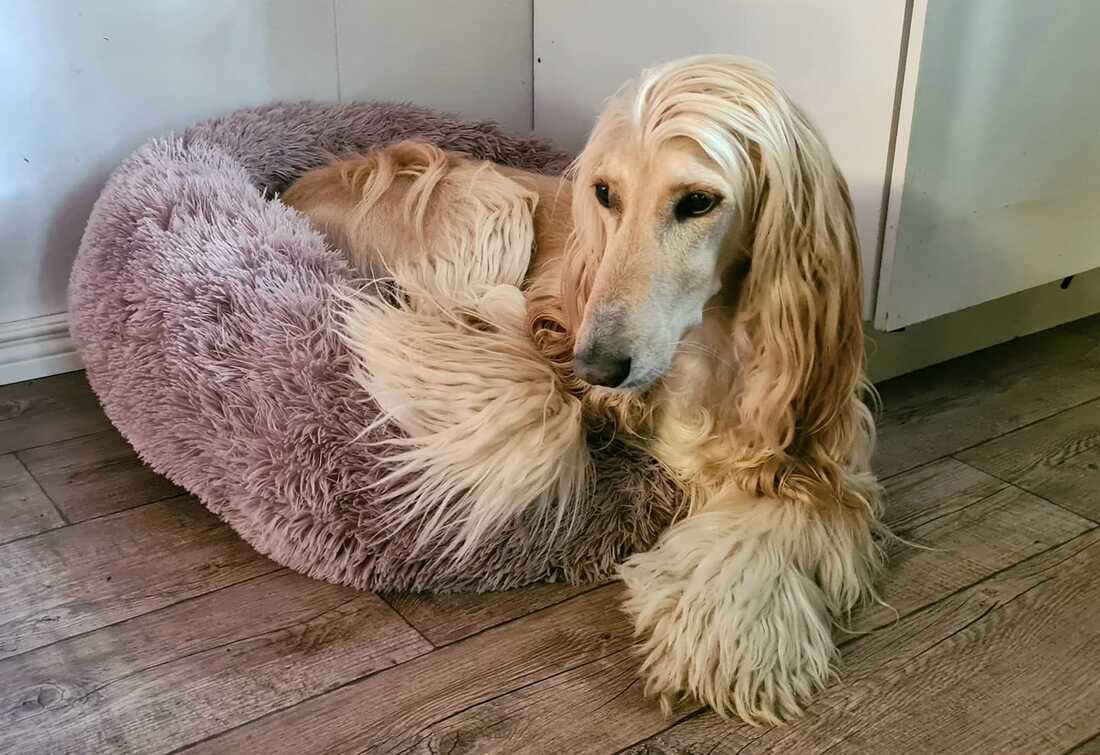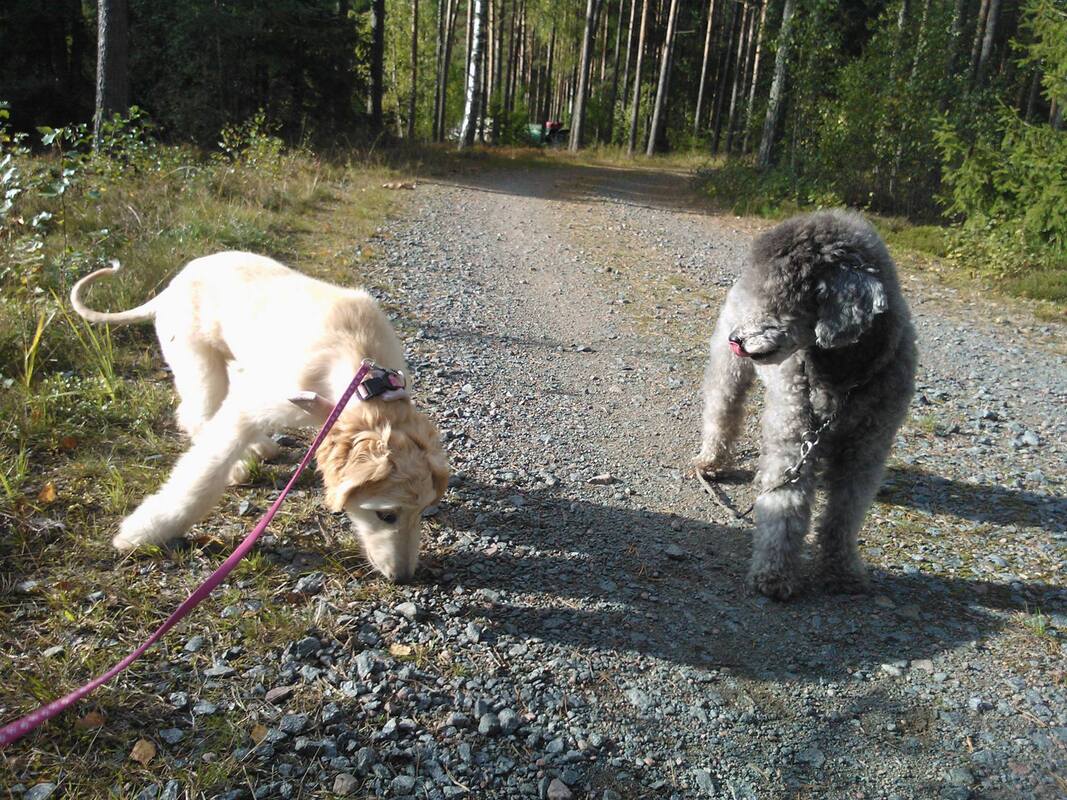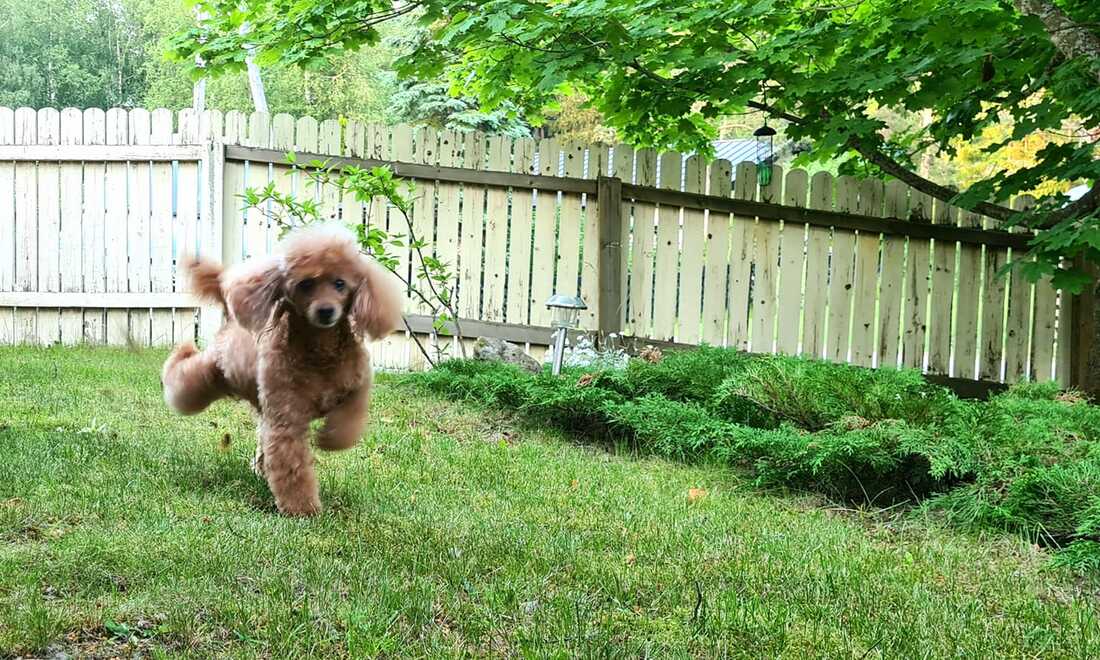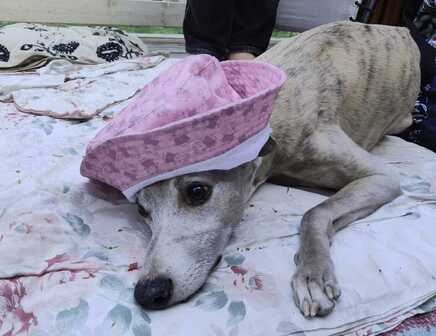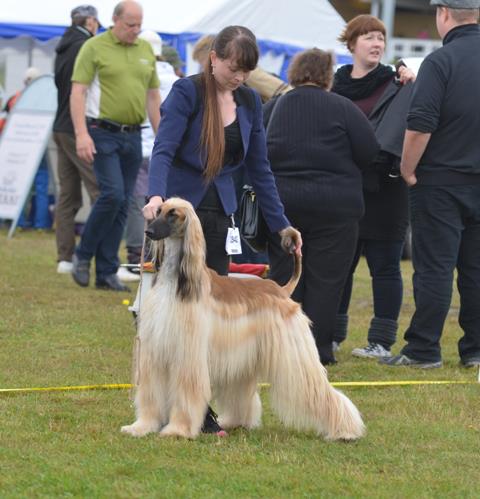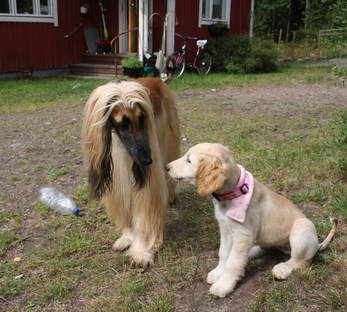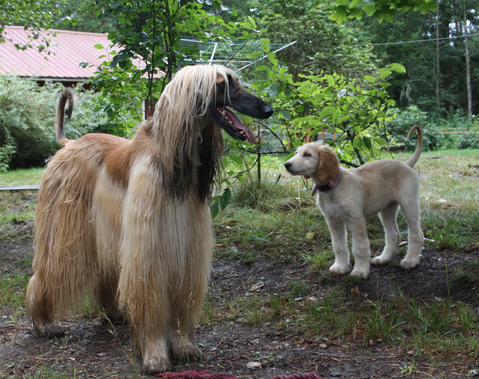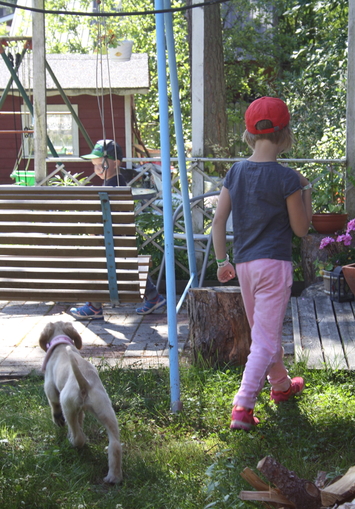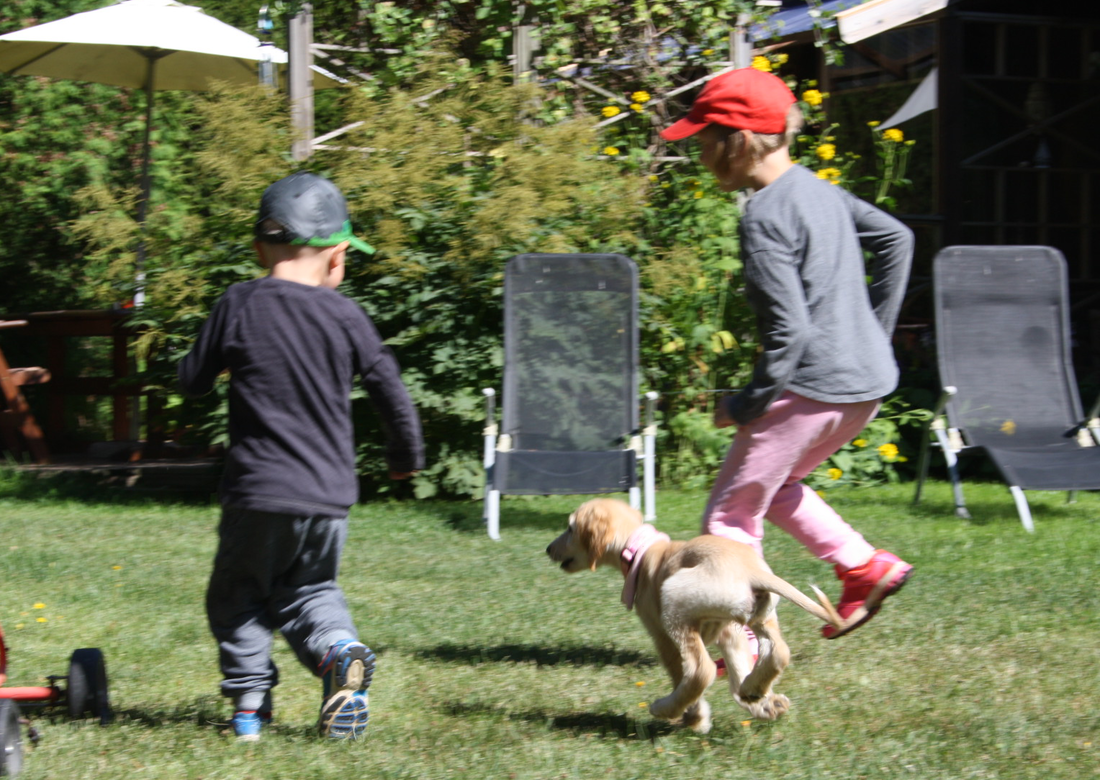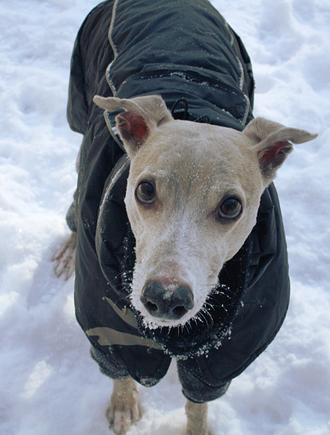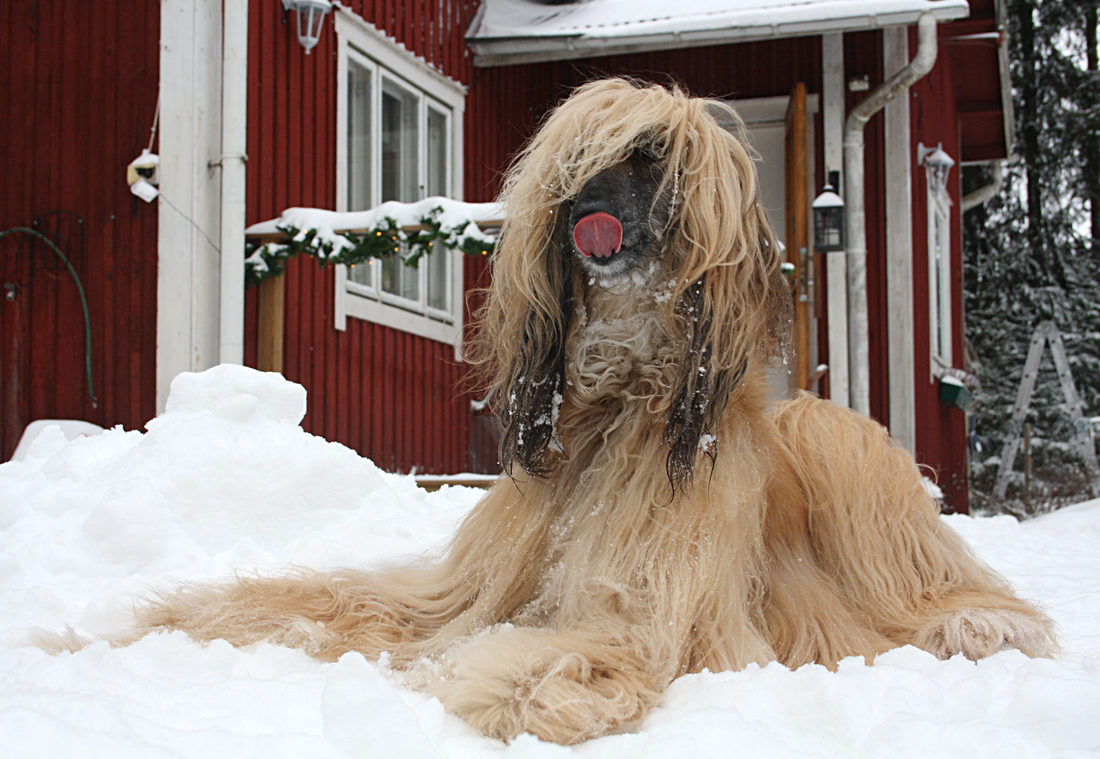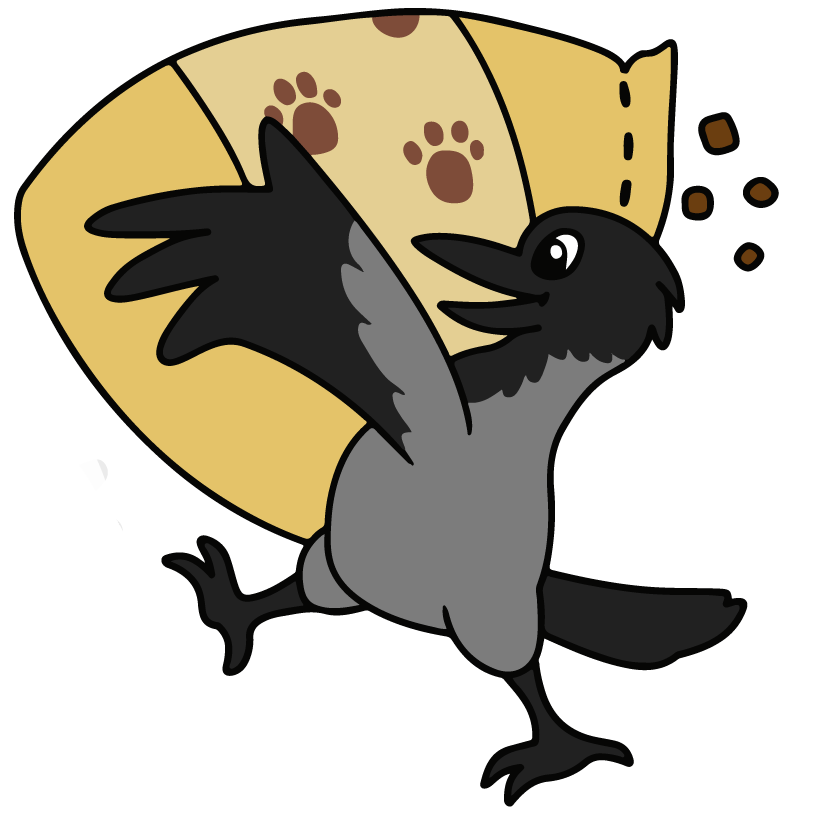|
Vuosi 2021 alkoi varsin kurjissa merkeissä Saksanpaimenkoiraliiton treeneistä oetuilla vastenmielisillä koulutusvideoilla. Vaikka en "terrorijärjestöjä" tuekaan, oli OE tässä kohtaa aivan oikeassa kuvatessaan treenejä salaa ja vuotaessaan videokuvan sen jälkeen julkiseksi. Mikään ei oikeuta ihmisiä kouluttamaan koiria, tai mitään eläimiä, väkivaltaisesti eikä sille myöskään ole syytä, jos oma taitotaso on kunnossa. SEYn sivuilla on voinut koko Eläinten viikon ajan tutustua kouluttamiseen, testata omaa koulutustietouttaan ja myös lukea Eläinten manifestin. Siinä kiinnitetään tänä vuonna huomiota eläinten kouluttamiseen ja sen etiikkaan. Koko manifestin voi lukea tästä linkistä, mutta käyn sen kohta kohdalta läpi myös tässä, sillä olen koko vuoden ottanut enemmäm tai vähemmän kantaa kouluttamisen etiikkaan ja kouluttajan valitsemiseen taidon, ei suurien puheiden perusteella. 1. Opi ymmärtämään minuaOlen toutottanut toitottamasta päästyänikin, miten tärkeää on ymmärtää kouluttamansa koiran rotutyypillistä käytöstä, viettejä ja perimää. Vaikka oppiminen tapahtuu aivoissa saman kaavan mukaan melko lailla kastemadoista ihmisiin, emme me kaikki suinkaan opi samalla tavalla. Koiramaailmassa halutaan usein vetää mutkat suoriksi ja sanoa, että yksi sopii kaikille. Näin ei kuitenkaan ole ja moni itsenäisten koirien omistaja turhautuu kursseilla, jos heidän koiransa itsenäisyyttä ei ymmärretä ja jos heille ei osata opettaa itsenäisen koiran motivointia. Koirankoulutuksessa tulee huomioida rodun ja koirayksilön erityispiirteet kuitenkin niin, ettei siinä milloinkaan alennuta pahoinpitelyyn, pelotteluun, pakottamiseen tai ahdistamiseen! 2. Opasta, rohkaise, älä alistaPositiivinen kouluttaminen ei sulje pois kuria. Kuri ei tarkoita alistamista. Alistamisella ei ole laumaeläimen kouluttamisen kanssa mitään tekemistä. Kyllä, voit saada koiran lopettamaan päälle loikkimisen hakkaamalla sitä köydellä niin, että se värjöttelee lopulta huoneen nurkassa eikä uskalla lähellekään, mutta kouluttamista tämä ei ole. Se on väkivaltaa. Kouluttajan ei koskaan tule alentua käyttämään väkivaltaa. Ymmärrys ja elekielen tulkitseminen auttavan etsimään ne keinot, joilla itsenäisen ja ohjaajakovankin koiran saa rauhoitettua ilman väkivaltaa. Jos saat ohjeeksi satuttaa koiraa tai "alistaa sitä", vaihda kouluttajaa. 3. Auta minua sopeutumaan ihmisten maailmaanSivusin aihetta hetki sitten kirjoittaessani kiirehtimisestä. Me odotamme koirilta paljon ja äkkiä. Emme välttämättä edes vaivaudu opettamaan niille asioita, vaan päädymme rankaisemaan niitä ja turhautumaan niiden tekemisistä, vaikkemme ole antaneet niille minkäänlaisia mahdollisuuksia onnistumiseen. Moni ihmisen mielestä ärsyttävä/hankala toiminta on koiralle täysin luonnollista. On epäreilua olettaa, että se osaisi käyttäytyä meidän, ihmisten, haluamalla tavalla, koska se on koira. Se käyttäytyy koiran tavalla, kunnes me opetamme sille muun käytösmallin. 4. Tutustu tarpeisiini huolellaLue, millaista koiraa olet ottamassa. Mieti, sovitko sinä sille koiralle. Kun valitset pentua, valitse pentu, jolle sinä sovit. Pyydä kasvattajaa auttamaan ja luota hänen tietotaitoonsa (valitse kasvattaja, johon voit luottaa! Tästä pitäisi ehkä kirjoittaa ihan oma juttunsa). Älä kuvittele, että saat kovallakaan vaivalla muovattua koirasta tietynlaisen, jos sen ominaisuudet eivät yksinkertaisesti sovi sinun elämääsi. Älä ikinä milloinkaan koskaan ota koiraa vain ulkonäön tai haavekuvan perusteella. Ole rehellinen ja realistinen myös niiden "huonojen puolien" suhteen; et välttämättä voi niille mitään. Ne on vain hyväksyttävä. 5. Tarjoa minulle turvaaKoirat tarvitsevat rajoja, lajinomaista tekemistä, kunnioittavaa kohtelua ja hyvää ruokaa ollakseen tyytyväisiä. Kukapa maailmassa ei tarvitsisi! Ota aina huomioon se mahdollisuus, ettei koirasta ehkä olekaan siihen harrastukseen/käyttötarkoitukseen, johon sen otit. Pidä mielessäsi, että se ansaitsee silti parasta - sinun luonasi tai muualla. Älä vie elävältä olennolta elämää pakottamalla sitä tekemiseen, joka ahdistaa sitä, laiminlyömällä sen perustarpeita tai jättämällä sen huomiotta. 6. Ole valmis mukautumaanLiittyy kohtaan 4. Valitse koira, joka sopii siihen toimintaa, jota haluaisit tehdä. Jos sinulle sattuu energinen koira, tee sen kanssa asioita. Älä oleta, että se rauhoittuu katsomaan Netflixiä kanssasi, jollet ole ensin tarjonnut sille sen energiatason ja vaatimustason kohtaavaa tekemistä. Jos sinulla on rauhallinen koira, älä väellä ja väkisin raahaa sitä kymmeneen harrastukseen viikossa, jos se selvästi alkaa oireilla väsymystään. Sinulla ei ole mitään oikeutta tehdä elävän olennon elämästä hankalaa ja ahdistavaa vain, koska itse päätit raahata sen elämääsi. Eläimellä ei ollut tilanteessa mitään sananvaltaa. Vastuu hyvästä elämästä on sinulla. 7. Hae apua ja ole valmis päivittämään osaamistasi Kun taito loppuu, väkivalta alkaa. Turhautuminen, ahdistuminen ja motivaation puute ovat kaikki täysin luonnollisia tuntemuksia minkä tahansa oppimisen kohdalla. Jos huomaat näiden tunteiden hallitsevan elämääsi koirasi kanssa, hae apua. Älä alennu käyttämään väkivaltaa, vahingollisia välineitä tai kuuntele huonoja neuvoja, jotka lupaavat nopeita tuloksia, vaikka se olisi miten houkuttelevaa. Taitava, osaava kouluttaja ei tarvitse väkivaltaa! On aika pyristellä eroon siitä, että positiivisesti kouluttavat kouluttajat ovat "osaamattomia nakin tuputtajia, joilla ei ole minkäänlaisia resursseja toimia oikeasti kovien koirien kanssa". Taitava kouluttaja osaa kyllä toimia myös vaativien, itsenäisten, välinpitämättömien, pidättyväisten, jopa arkojen ja aggressiivisten koirien kanssa joutumatta turvautumaan väkivaltaan. Jos joku tarjoutuu nykimään koiraasi pannasta liinan avulla sinun keskittyessäsi ohjaamiseen, jos joku tarjoaa sinulle sähköä, jotta "saadaan koira nippuun", jos joku kehottaa sinua rankaisemaan koiraa väärästä suorituksesta, sano EI. Sinulla on oikeus, ja velvollisuus, vaatia osaavaa kouluttajaa! LopuksiOlen kouluttanut monia koirakkoja, mutta mieleeni on elävästi jäänyt yksi. Vedin silloin kolme irtokoulutustuntia remmirähisevälle itsenäisen ja reaktiivisen rodun edustajalle ja hänen turhautuneelle omistajalleen.
Ensimmäisellä tunnilla tarkkailimme ja opettelimme helpottavia käskyjä sekä kontaktia. Toisella ja kolmannella käynnillä meillä oli käytännön ohitusharjoituksia yleisellä lenkkipolulla. Viimeisen tunnin alussa huomasin, miten koira alkoi jo pitkältä toiset koirat huomatessaan tarjoamaan katsekontaktia. Muista koirista oli tehty sille merkki omistajalta saatavasta palkkiosta. Sen reaktiot olivat matalaenergisempiä ja ne oli helppo keskeyttää paria yllättävää tilannetta lukuunottamatta kevyellä hihnapakotteella ("Katso tänne!") ja kontaktin ottamisella. Suurimman osan ajasta se tarjosi kontatia itse ja muutaman ohituksen se selvitti moitteetta jopa toisten koirien rähinästä huolimatta. Monen vuoden mittainen, iso ongelma oli kahden viikon itsenäisellä harjoittelulla ja kolmella vedetyllä tunnilla lähes kurissa. Koira käyttäytyi lenkeillä rennommin, luottavaisemmin, ja se luotti omistajansa harkintakykyyn. Kuulemma muutos näkyi myös muualla arjessa; koira kuunteli, totteli ja se nautti tekemisestä. Omistaja oli tehnyt koiran kanssa aivan uskomattoman hienon, ison työn. Hän ei lopulta tarvinnut siihen kuin välineitä itsenäisen, reaktiivisen koiran hallintaan ja sen käyttäytymisen ja käytöksen syiden ymmärrykseen. Viimeisimmältä tunnilta lähtiessään hän totesi olevansa aika luottavainen sen suhteen, että he pärjäävät nyt kahdestaan. Tällaisten asioiden kuuleminen saa minut aina uskomattoman iloiseksi, sillä se todistaa, miten pitkälle ihan pelkkä ymmärrys meidät jo vie. Koirat, ne kyllä osaavat lukea meitä kuin avointa kirjaa. Me vain tarvitsemme joskus vähän vinkkiä niiden lukemiseen. Alla hauska kuvakaksikko. Ylempänä on vuonna 2002 napattu kuva minusta ja perheemme tällöin 7-vuotiaasta kääpiövillakoira Sunnysta. Sunny oli minun lähtölaukaukseni koiramaailmaan. Käytin mielelläni vapaa-aikani sen turkinhoitoon, kouluttamiseen, ulkoiluun ja yhdessäoloon. En koskaan edes kaivannut "hurjaa nuoruutta", sillä minä viihdyin oikein hyvin kotona koirajutuissa. Alempana on viime viikonloppuna räpsäisty kuva minusta ja Sotaperunasta. Olen edelleen samalla tiellä, edelleen aivan yhtä innoissani koirista, ja rakastan niitä edelleen perheenjäseninäni aivan yhtä paljon. Tänä vuonna vietin 26:tta vuottani koirien kanssa.
0 Comments
Sivusin aihetta pari blogipostausta aiemmin puhuessani roduntuntemuksesta ja siitä, että osa koirista tarvitsee aikaa. Koen aiheen olevan kuitenkin niin tärkeä, että se ansaitsee ihan oman postauksensa siitäkin huolimatta, että syksy on taas tehnyt sormistani jäykät ja kipeät. Koirat kehittyvät kaikki yksilöllisesti ja omaan aikaansa. Osa koirista on varsin rauhallisia yksivuotiaina, osa on vielä täysin pentuja. Koirien kehityskaaresta on tehty kaikenlaisia karkeita arvioita suurinpiirteisine ikään liittyvine virstanpylväineen. Yksi tällainen esitellään hankikoira.fi-sivustolla. Pidän tätä itse varsin hyvänä rankana ja suuntaa antavana näkemyksenä. Ensiviikkojen ja murrosiän jälkeen mainitaan koiran olevan yleensä aikuinen n. 2-3 vuoden iässä. Me kuitenkin odotamme usein saumattoman hyvää ja moitteetonta käytöstä jo koiranpennuilta, teinikoirista puhumattakaan. Tämä on epäreilua, typerää ja edesvastuutonta ja johtaa pahimmillaan räikeisiin, jopa väkivaltaan johtaviin turhautumisen ja ahdistuksen tunteisiin. 6kk iässä sinä opit tunnistamaan äitisiEn voi sanoa tietäväni ihmislapsien koulua edeltävistä ikävuosista aivan valtavasti, mutta tiedän sen verran, että n. puolivuotias ihminen on oppinut tunnistamaan vanhempansa ulkonäköperusteisesti ja äänestä, osaa maata selällään ja osaa jo jotenkuten hallita päänsä liikkeitä. Arvaa, mitä me odotamme tämän ikäisiltä koirilta? Moitteetonta odottamista, hyvää käytöstä, loikkimattomuutta, käskyjen tunnistamista ja noudattamista, hienoa hihnakävelyä, jättämistä, sisäsiisteyttä, laumakäytöksen alkeita ja kontaktia. On aivan totta, että koirat ja ihminen ovat eri lajia. Koira kehittyy nopeammin. On kuitenkin epäreilua, miten me edellytämme koirilta aikuismaisen hallittua käyttäytymistä niiden vielä käydessä läpi varhaispuberteettiaan. Itse asiassa, osa koirista ei ole vielä edes aloittanut teini-ikäänsä 6kk ikäisenä. Silti me odotamme niiltä jo hyvää itsehillintää ja tottelevaisuutta. Osa koiranomistajista ei yksinkertaisesti tunnista koiran kehitysvaiheita. Toinen puoli tunnistaa, mutta ryhmäpaine ja omat odotukset saavat ne unohtumaan. Kovat odotukset sekä ulkopuolisilta että itseltä yhdistettynä pennun/teinikoiran arvaamattomaan käytökseen ja sille täysin luonnollisiin temppuiluihin johtavat turhautumiseen. Turhautuminen taas usein johtaa kiukkuun ja kiukku purkautuu koiraan. Toinen turhautumisen mahdollisista purkautumisteistä on välinpitämättömyys, apaattisuus ja turtuminen - ei jakseta tehdä mitään eikä puuttua mihinkään, koska mistään ei tunnu olevan apua. Jos kiehuu yli (KUN kiehuu yli)Jokainen meistä suuttuu ja jokainen meistä turhautuu. On valhetta väittää, etteikö koiranomistajana koskaan löytäisi itseään tilanteesta, jossa kuppi kaatuu, pato murtuu, viimeinen korsi katkaisee naapurinkin kamelin selän ja verisuoni tykyttää otsassa niin, ettei muuta kuulekaan. Vaatii itsehillintää, ymmärrystä ja osaamista toimia kiihtymyksen alaisena. Meidän on muistettava, että olemme tekemisissä nuoren koiran kanssa ja sitouduttava jaksamaan sitä sen koko koulutusprosessin ajan. Enkä tarkoita nyt sitä, ettei koiralle saisi suuttua. On kuitenkin ehdottomasti parempi lähteä suututtuaan hetkeksi rauhoittumaan tai hammasta purren pakottautua rauhalliseksi kuin tuhota luottamusta riehumalla. Minulle koiranohjaajana haastavinta, varsinkin omien rotujeni kanssa, on itsehillintä. Ärryn ja lauhdun verrattain helposti, mutta kunnolla suututtuani minulta menee paljon aikaa rauhoittumiseen. Tämä on ongelma, sillä afgaanit ovat henkisesti täysiä pentuja vielä kaksivuotiainakin, osa siitäkin pidempään, mutta kooltaan ne ovat jo aikuisia. Presa canario on painava, voimakas koira jo puolen vuoden ikäisenä. Olen joutunut erikseen opettelemaan itsehillintää ja vaihtoehtoisia toimintatapoja tilanteisiin, joissa tekisi mieli vain huutaa, potkia ja hyppiä tasajalkaa. Koira ei ole ikinä syypää siihen kohdistuvaan arvaamattomaan, fyysiseen kuritukseen, oli se tehnyt mitä tahansa. Koiran tekemiset saattavat olla syy kuritukseen, mutta ne eivät ole sille oikeutus. On myytti, hölynpölyä, että koira tarvitsisi kunnon kurinpalautuksen ja riepottelun tehtyään jotakin sopimatonta. Toki sen käyttäytymiseen täytyy puuttua, mutta taitava koiranohjaaja ei tarvitse siihen ylimitoitettua sekoilua. Taito antaa koiralle palautetta tai pakote mahdollisimman vähäeleisesti ja hillitysti ja saada koira tällä tavoin rauhoittumaan on yksi osaavan koiranohjaajan tunnusmerkeistä. Jos ei vaan jaksa (KUN ei vaan jaksa)Apatia ja välinpitämättömyys johtavat toisenlaisiin laiminlyönteihin; koira jää vaille koulutusta, ehkä jopa vaille aktivointia ja liikuntaa. Temppuilevan ja tempoilevan koiran kanssa ei halua lähteä mihinkään, koska se aiheuttaa stressiä ja ketutusta. On helpompaa jäädä kotiin ja sulkea koira vaikka tarhaan, häkkiin tai heittää se pihalle yksikseen. On tärkeää ymmärtää, ettei koira osaa olla tarkoituksella rumasti sanottuna perseestä. Se on nuori ja vilkas, ei vielä tiedä eikä jaksa muistaa kaikkea. Se ei opi, jos sen kanssa ei tee. Se ei rauhoitu, jos sen mieli käy ylikierroksilla. Kaikki koiran kanssa tapahtuva toiminta ei aina ole hauskaa, mutta se on pakko tehdä. Netti on piukassa kursseja, joissa luvataan nopeita tuloksia, tyylikkäät ja mietityt Instagram-postaukset ja kulppeat treenivideot luovat kuvaa siitä, miten onnistunut koiranomistaja on aina iloinen ja hänen koiransa pennusta asti ihan pro niin arjessa kuin harrastuksissa. Tämä valheellinen kiiltokuvamaisuus on toki kaunista ja viihdyttävää, mutta hohdokkuuden ylistämisellä on myös synkkä puolensa; se saa ihmiset ajattelemaan, että kaikki paitsi SUPERRRRRRR KOIRA! on aina merkki epäonnistumisesta. Niinpä siihen superkoiraan pyritään yhä vain nopeammin, yhä vain sokeammin. Tosiasiassa iso osa treenistä on kamppailua omaa taitamattomuuden tunnetta vastaan. Jälleen kerran tähdennän, että osaava koiranohjaaja hallitsee mielentilansa ja tiedostaa, koska voidaan tehdä etenevää ja vaativaa treeniä ja koska on vaan parempi nakella palloa. Hän myös ymmärtää, että jos väsymys pikkuhiljaa hiipii jatkuvaksi tunteeksi, korjausliike on tehtävä. Koira ei voi kasvaa tiedostavaksi, oikein toimivaksi aikuiseksi ilman ohjausta. Mitä voin tehdä?Kiirehtimisen kulttuuria vastaan voi taistella vain olemalla kiirehtimättä. Hyväksymällä sen, että etenee mieluummin koiran ehdoilla, ehkä sitten vähän hitaammin, kuin muiden odotusten ja omien odotuksiensa sokaisemana. Se on joskus hirvittävän vaikeaa, mutta se maksaa itsensä takaisin. Kiirehtimällä ja vaatimalla koiralta liikaa liian nopeasti kuormitetaan koiran mieltä täysin tarpeettomasti. Antamalla koiran kasvaa rauhassa ja ilman turhaa omistajaan kohdistuvaa ahdistusta, pelkoon perustuvaa miellyttämisen tarvetta ja stressiä tuetaan vakaan, itsevarman koira-aikuisuuden syntyä. Pentujen kuuluu hepuloida ja sekoilla, teinikoirien kuuluu kapinoida. Hyväksy se, luovu epärealistisista odotuksista ja iloitse onnistumisista. Väitän, että suuri osa kiirehtimisen kulttuurista opitaan harrastuskentän reunalla. Olisi tärkeää ymmärtää, että virhettömyys ottaa aikaa. On vielä tärkeämpää alleviivata nuorille ja vasta aloittaneille harrastajille, että jokaisen onnistuneen suorituksen takana on satoja, tuhansia toistoja. Jos me itse kiirehdimme ja kasvatamme muita kiirehtimään, teemme karhunpalveluksen koirille. Niiden tulisi olla kaikessa tekemisessä etusijalla. Lopuksi, vaikka onkin hyvin paheksuttavaa olla tätä mieltä; liian rajut otteet, jatkuva turhautumisen tunne ja väkivalta kertovat usein siitä, että koiran ominaisuudet ja vaatimukset ja ohjaajan taitotaso eivät kohtaa toisiaan. Tästä syystä olisi ensiarvoisen tärkeää selvittää itselleen, millainen rotu/koira omaan arkeen, omaan osaamiseen ja omaan tekemiseen sopii. Toki itseään voi kehittää ainoastaan ottamalla haasteita vastaan, mutta täysin toisiaan kohtaamattomat vaatimukset ja taidot aiheuttavat vain ja ainoastaan turhautumista. Ilman opettelua ei opiKukaan ei ole seppä syntyessään, Roomaa ei rakennettu päivässä ja tukku muita vanhoja sananlaskuja muistuttavat meitä siitä, että onnistuminen ja hyvät asiat vaativat työtä ja aikaa. Ilman työtä, panostusta, aikaa ja aktiivista opiskelua kukaan ei voi oppia mitään.
Koiranohjaajalla soisi olevan tervettä halua kehittää itseään. Omien virheidensä tunnistaminen on ensimmäinen askel kohti onnistumista. Se toinen askel on kova ja aktiivinen työ ja itsensä kehittäminen. Palkintona kaikesta meillä on toimiva yhteistyö koiran kanssa ja koira, joka haluaa toimia kanssamme omasta vapaasta tahdostaan, koska toiminnasta on sille hyötyä. Meidän on jo aika opetella pois siitä käsityksestä, että koiralla olisi jonkinlainen korkeammalta laskeutuva pyhä tahto toimia kanssamme ilman minkäänlaista itsekästä kannustinta. Myös tämä auttaa pääsemään eroon kiirehtimisen kulttuurista; jos me kaikki ymmärtäisimme, mikä meidän koiraamme motivoi, ehkä me jaksaisimme perehtyä sen motivaation kehittämiseen ja hyödyntämiseen sen sijaan, että olettaisimme yhden sopivan kaikille ja turhautuisimme, kun näin ei ole. Lukutaitoa on pidetty yhtenä ihmiskunnan keskeisimpänä taitona kohti sivistystä. Kun opimme keinon kommunikoida keskenämme, siirtää ja säilöä tietoa, oli meillä mahdollisuus lisätä tietouttamme lähes rajattomasti. Lukutaito on yhä edelleen yksi tärkeimmistä askelista kohti parempaa, tasa-arvoisempaa ja sivistyneempää maailmaa. Kun puhutaan koiranlukutaidosta, puhutaan kyvystä lukea ja ymmärtää koiran eleitä ja sen käytöstä ja käytöksen syitä. Aivan kuten ihan lukutaidonkin, myös koiranlukutaidon avulla voimme lisätä koirien (ja itsemme) hyvinvointia ja lisätä ymmärrystämme toimiessamme näiden eri kieltä puhuvien, mutta kanssamme auliisti kommunikoivien otusten kanssa. Puhuin taannoin yhden tuttavani kanssa Kennelliiton kasvattajan peruskurssista. Olimme yhtä mieltä siitä, että kurssilla painotettiin uskomattoman paljon ihan perusasioita. Tästä pääsimme keskustelemaan koira-ajokortista ja siitä, olisiko se sittenkään niin surkea ajatus. Työläs, totta kai, mutta kuinka monelta ongelmalta vältyttäisiin, jos perusasiat opetettaisiin ihan tavan koiranomistajille, kasvattajista nyt puhumattakaan. Koiranlukutaidolla tarkoitetaan kykyä lukea koiraa ja sen tunnetiloja sekä ennakoida sen käytöstä. Tämä on taito, jonka oppii vain koiraa seuraamalla. Harvoissa tapauksissa sanon, että pelkkä lukeminen ei riitä, mutta tässä tapauksessa se ei todellakaan riitä; koira on nähtävä, koettava ja sen kanssa on vietettävä aikaa sekä sitä on seurattava sen jokapäiväisessä elämässä. Netistä löytyy hyviä kuvallisia ohjeita koirien eleiden lukemiseen. Näissä usein piirretyissä kuvakollaaseissa on käyty läpi koiran peruselekieltä ja ne sopivatkin hyväksi ohjenuoraksi ihmisille, joilla ei ole koiraa. Jokainen koiranomistaja kuitenkin tietää, että kuvaesimerkit ovat hyvin liioiteltuja ja koiran eleet ja niiden selkeys vaihtelevat rodun, koirayksilön ja iän mukaan. Pennut ja ystävälliset koirat ovat usein liioitellun selkeitä eleissään, sillä ne tahtovat tehdä selväksi, etteivät tarkoita pahaa. Monelle vahtikoiralle vähäeleisyys sen sijaan on enemmän sääntö kuin poikkeus; voimakastakin reaktiota voi edeltää pelkkä silmänvalkuaisen vilahtaminen. Osaatko lukea koiraasi oikein?Harva koira on salakavala. Suurin osa koirista haluaa tulla kuulluksi ja ne puhuvat meille ja toisilleen omaa kieltään selvästi ja kuuluvasti ennen kaikkea silloin, kun ne tuntevat olonsa kurjaksi. Suurin osa koirista kun ei halua aiheuttaa mitään ylimääräistä säätöä. Ne haluavat olla rauhassa ja tyytyväisiä ja jos jokin tai joku estää niitä olemasta tällaisia, ne kommunikoivat tilanteen selvittääkseen. Koska koirat eivät osaa pukea tunteitaan sanoiksi meidän on opeteltava puhumaan niiden kanssa niiden omalla kielellä; eleillä, ilmeillä, energialla ja olemuksella. Jos oman koiran reaktiot tuntuvat arjessa yllättäviltä, jos hoitotoimenpiteet eivät suju tai jos koira ei kuuntele, kysy itseltäsi, miksi. Jos koira ei ole kipeä, teini, juoksuinen narttu, hormoniensa juuri sillä hetkellä vietävissä oleva uros tai muulla vastaavalla tavalla jostakin ohimenevästä syystä vähän sekaisin, ehkä et yksinkertaisesti ymmärtänyt sen kertoneen sinulle "anteeksi, mutta voitko olla survomatta niitä kynsisaksia tassuihini juuri nyt, KIITOS". Ja oikeasti; kommunikaatiokatkoksia tapahtuu kaikille! Ei kukaan, edes ammattilainen, ole aina 100% tilanteen tasalla. Puhummehan me ihmisetkin samaa kieltä keskenämme ja silti välillä kyselemme "täh?". Miten esimerkiksi hoitotoimenpiteessä sitten tulisi toimia? Mitä hyötyä koiranlukutaidosta on vaikka niitä kuuluisia kynsiä leikatessa? Jos osaamme ymmärtää koiraa, pystymme ennakoimaan sen toimintaa. Jos koira selvästi kertoo, ettei se halua kynsiään leikattavan, meidän tulee tehdä tilanne sille mukavaksi. Lisäksi meidän tulee eleillämme ja käytöksellämme kertoa, että olemme pahoillamme, mutta homma nyt vaan tulee suorittaa, koska se on jokaisen edun mukaista. Otin kynsien leikkuun esimerkiksi siksi, että meillä käy paljon kynnenleikkuuasiakkaita. Muut kuin käytökselliset syyt ovat vähemmistö. Suurin osa asiakkaista tuo koiransa kynneleikkuudeen, koska koirat eivät anna leikata kynsiään kotona. Ne murisevat, näykkivät ja sätkivät. Yleensä epäonnistuneen kynnenleikkuun takana on kommunikaatio-ongelma ja tottumattomuus. Koira ei halua tassujaan koskettavan, koska se tuntee olonsa epävarmaksi. Ihminen saattaa pelätä sen hampaita tai muulla tavalla osoittaa, ettei ole ihan varma siitä, mitä on tekemässä. Tämä saa koirankin kyseenalaistamaan tilanteen sen lisäksi, että suurin osa koirista on ennen kaikkea etutassuistaan varsin kosketusherkkiä. Kun ihminen varoo, koira varoo ja homma ei onnistu, ei sitä lopulta edes jakseta tai haluta viedä loppuun ja ongelma on syntynyt. Avain mihin tahansa onnistuneeseen perustoimenpiteeseen on onnistunut kommunikaatio ja itsevarmuus. Koira odottaa ohjeita, joten meidän tulee antaa ne selvästi, itsevarmasti ja luotettavasti. Niin suuri klisee kuin se onkin, koiran kynsiä oppii leikkaamaan vain leikkaamalla koiran kynsiä, ja koira tottuu kynsien leikkaamiseen vain, jos sen kynsiä leikataan ja tassuja pidellään usein. Ymmärtämällä, mitä koira meille sanoo, pystymme etenemään opiskelussa koiran vaatimalla ajalla, tavalla ja energialla. Herkkähipiäiselle, lähes kuurosokealle Kenraalimajurille on tehtävä sivelemällä ja koskemalla selväksi, että nyt leikataan kynnet. Ne täytyy leikat yksi kerrallaan, nätisti, hötkyilemättä ja ajan kanssa. Sotaperunan manikyyri on täysin toisenlainen; se pysähtyy omista touhuistaan minuutiksi asenteella "noninoni, valmista tulee, nopeesti" ja kun kynnet on supernopeasti napsittu, se singahtaa takaisin omiin hommiinsa (viime aikoina esimerkiksi repimään liljoja tai tuhoamaan sitä yhtä ainoaa puskaa, josta olen kovin tarkka ja jota hoivaan ja varjelen joka kesä). Kumpikin koirista kertoo minulle omalla tavallaan ja omilla eleillään, mikä tyyli heille sopii. Minä mukaudun heidän tarpeisiinsa tehden kuitenkin selväksi, että ne kynnet on leikattava. Samalla tavalla asennoidun asiakkaisiin. Kunnioitan koiran sanomaa, mutta teen selväksi, että olen täällä töissä ja minulla on tänään menoa muuallekin. Keskustele koiran kanssaKuten sanoin aiemmin, koiranlukutaidon oppii keskustelemalla koiran kanssa ja seuraamalla sen keskustelua muiden kanssa. Laumakommunikaation seuraaminen on oikeasti äärimmäisen mielenkiintoista ja koirien keskenään käymä jatkuva keskusteku uskomattoman antoisaa katseltavaa. Yksittäinen koira kommunikoi sekin jatkuvasti, yleensä ihmiselle, ja saatat monesti huomata, että ihmisen kanssa keskustellessaan koira on huomattavasti selväsanaisempi kuin puhuessaan lajitoverilleen.
Koirat ovat siis usein meitä kohtaan varsin kohteliaita ja puhuvat meille OIKEIN SELKOKIELISESTI, jotta me varmasti YMMÄRRÄMME. Silti emme joskus ymmärrä. Se mahtaa olla turhauttavaa. Säästäkäämme siis koiria ja antakaamme niille arvostusta oppimalla edes peruskielioppi. Silläkin pääsee jo pitkälle. Alla huvin ja urheilun vuoksi muutama keskustelukuva. Häkittäminen on koiramaailman kuuma peruna. Kukaan ei halua ottaa häkkiin mitään oikeaa kantaa; se on AINA väärin, paitsi harrastuksissa, lääkärin määräämänä tai hotellissa. Häkkiin on totutettava, mutta siinä ei saa olla. Häkki ahdistaa, mutta oikeissa tilanteissa se rauhoittaa. Häkki luo stressiä, mutta toisissa tilanteissa poistaa sitä. Sekavaa? Älä. Avataanpa hieman sitä, mistä on kyse. Häkki. Suomisanakirja.fi sanoo häkin olevan "Koppimainen rakennelma, jonka katto ja seinät (tai ainakin yksi niistä) on tehty (metalli)tangoista, verkosta tms." Koiramaailmassa häkki tarkoittaa yleensä tarhaa pienempää, mahdollisesti mukaan taittuvaa metalli- tai kangasviritelmää, joka tukirakenteidensa avulla saadaan pystytettyä verrattain nopeasti ja jonka sisällä koiran tulisi mahtua istumaan, makaamaan rennosti ja seisomaan. Häkittäminen nousi tapetille jo vuosikausia sitten eläinsuojelujärjestöjen tehdessä hyvää työtä koirien ja muiden otuksien paremman elämän puolesta. Eläinsuojelulaki ei kuitenkaan mainitse kuljetushäkeistä, näyttelyhäkeistä tai harrastushäkeistä ihan kamalasti. Niissä otetaan kantaa lähinnä isompiin, koiran säilömiseen tarkoitettuihin tarhoihin. Pienemmistä häkeistä sanotaan ainoastaan seuraavaa: "”Kissaa tai koiraa taikka muuta eläintä saadaan pitää sen kuljetukseen tarkoitetussa laatikossa tai häkissä taikka muussa vastaavassa pienikokoisessa säilytystilassa vain, jos eläimen kuljettaminen, sairaus tai muu tilapäinen ja hyväksyttävä syy sitä vaatii.” Mikä on tämä "muu tilapäinen ja hyväksyttävä syy"? Tässä tulee vastaan lain tulkinnanvaraisuus. Esimerkiksi minulle aggressiivisen rodun omistajana hyväksyttävä syy on muiden eläinten ja aggressiivisen eläimen itsensä turvallisuuden takaaminen. Tilapäisyyden tulkitsen niin, ettei koiraa saa säilyttää pienessä häkissä pitkiä aikoja eikä silloin, kun sille on mahdollista taata muulla tavoin turvallinen ympäristö, jossa se ei ole muille vaaraksi. Kauanko häkissä saa viettää aikaa? Tämäkin on tulkinnanvaraista. Mitään tarkkaa aikarajaa ei ole määritelty. Tilapäisyys viittaisi kuitenkin siihen, ettei otus ole siellä toistuvasti pitkiä aikoja. Miten sitten esimerkiksi öiden nukkinen häkissä? Työkoiran pitkät päivät häkissä auton takana? Kummassakin tapauksessa kyseessä on perusteltu syy (kuljettaminen, lemmikin turvallisuuden takaaminen), mutta koira on häkissä toistuvasti, kuitenkin tilapäisesti. Suomen häkkilaki on siis aika tiukka, vaikka sitä miten tulkitsisi. Kuitenkin esimerkiksi Yhdysvalloissa koirat ovat poissaolojen ajan lähes poikkeuksetta häkissä. Crate training on tärkeä osa sikäläisen koiranpennun yksinolo-opetusta. Myös Suomessa häkittämiseen törmää useimmiten juuri yksinolon kanssa. Jonkin verran siihen törmää myös silloin, jos talossa on useita koiria, jotka eivät tule toimeen keskenään ja kaikille olisi taattava tarpeeksi sosiaalista kontaktia ja vapautta. Puolensa ja puolensaHäkki ei aiheuta koiralle traumoja, mikäli häkissä oleminen ei ole koirasta epämukavaa tai sitä ei säilytetä siellä toistuvasti pitkiä aikoja sen ollessa hereillä. Öiden nukkuminen häkissä tuskin stressaa yhtäkään otusta, jos häkki on sille kyllin tilava. Jotkin koirat myös selvästi rauhoittuvat päästessään "luolaan" ja oikein sijoitettu, peitetty, pehmoinen häkki voi myös auttaa esimerkiksi hermostuneen lemmikin totuttamista vieraisiin. Häkki ei kuitenkaan oletusarvoisesti ole jokaisen koiran lempparipaikka. Hereillä ollessaan häkissä odottava eläin herkästi turhautuu. Kun koiralla on halu tehdä, sillä olisi energiaa tehdä, mutta se on suljettuna pieneen tilaan se ahdistuu ja stressaantuu. Hetkellisesti hereillä odottamisesta ei ole haittaa, vaikkei koira siitä kamalasti nauttisikaan (vaikkapa harrastuksissa oman vuoron odottaminen), mutta toistuvasti ja pysyvästi liian pitkiä aikoja häkissä viettäneet eläimet alkavat ilmentää stressiä ja käyttäytyvät impulsiivisesti. Niillä on valtavasti patoutunutta energiaa, jota ne epätoivoisesti haluavat purkaa ihan mihin tahansa. Juuri patoutuvan energian aiheuttaman stressin takia esimerkiksi itsensä tuhoilulla vaarantavan koiran häkittäminen työpäivien ajaksi on kaksipiippuinen asia; toisaalta se on perusteltua, monesti jopa ihan oikeasti tarpeellista, jos koira tuhoaa KAIKEN ihan vain nuoruuden innossaan (ja uskokaa minua, näitä koiria on. Jokaisella tuhoavalla koiralla ei suinkaan ole pitkittynyttä tylsyyttä tai eroahdistusta. Ne vain tykkäävät askarrella), mutta vaakakupin toisella puolella vaanii rajoittamisen aiheuttama stressi. Tämä stressi voi päin vastoin pahentaa tuhoilua. On siis ehdottomasti tarpeen pyrkiä mahdollisimman nopeasti pois työpäivähäkittämisestä tuhoilun vuoksi. Tämä vaatii yksinoloharjoittelua, treenaamista ja koiran elekielen tuntemista. Häkki on siis väliaikainen työkalu, jolla varmistetaan koiran turvallisuus pidempien poissaolojen ajan, ei suinkaan pysyvä ratkaisu. Työkaluna häkkiä ei kuitenkaan tule väheksyä, sillä esimerkiksi kodinvaihtaminen nuoruuden intotuhoilun vuoksi on ylimitoitettu ja koiraa huomattavasti enemmän stressaava ratkaisu. Joissakin tapauksissa, hyvin harvoin, häkki ON pysyvä ratkaisu esimerkiksi poissaolojen ajaksi. Tällasia tapauksia on kuitenkin erittäin vähän ja syy on yleensä aina terveydellinen (henkisesti tai fyysisesti). Häkkiin tulee opettaa, jotta häkki on koirasta mukava mesta. Osa koirista oppii pitämään häkistä huomatessaan, että siellä on kivaa, rauhallista ja turvallista. Osa koirista on sitkeästi sitä mieltä, että maailma ulkopuolella on häkkiä kivempi paikka. Tällaisille koirille häkistä on tehtävä miellyttävä paikka. Kivan kauttaMeillä on lähes aina avonainen häkki olohuoneessa ja olen totuttanut koiria sinne nakkelemalla häkkiin nannaa tai ruokkimalla mahdollisen pennun siellä. Kaksi aikuisista koiristani pyrkii häkkiin nukkumaan, jos häkin ovi on auki, vaikka niillä olisi mahdollisuus valita mikä tahansa muu paikka. Kaksi suhtautuu häkkiin neutraalisti. Sotaperuna nukkuu mielellään häkissä yöllä, mutta ei muuten välittäisi olla siellä edes sitä 30 sekuntia, jonka aikana muut koirat ohittavat sen ulos mennessään. Jokainen osaa tarvittaessa rauhoittua häkkiin odottamaan, mikä on näyttelyissä ja muissa harrastuksissa usein tarpeen ja eduksi. Minulla on aina ollut tapana mieluummin opettaa ja kouluttaa koira hyvällä hyväksymään asioita kuin puhtaasti vaatia sitä alistumaan kohtaloonsa. En sano, ettenkö vaatisi joitakin asioita, mutta hyvin usein valitsen opettamisen. Tiedän ihmisiä, oikein hyvä koiranomistajia, jotka vaativat mieluummin kuin opettavat tällaisista asioista puhuttaessa, eikä tästä ole näyttänyt olevan heidän koirilleen mitään haittaa. Itse pidän siitä, että koirat valitsevat tehdä kuten haluan niiden tekevän. Minulla on se kokemus, että voin tällä tavalla toimiessani luottaa koirieni päätyvän omalta kannaltani miellyttäviin ratkaisuihin silloinkin, kun en ohjeista niitä. Tämän saman syyn takia käytän kouluttaessani positiivista vahvistamista, mutta se nyt on täysin toisen blogipostauksen aihe. 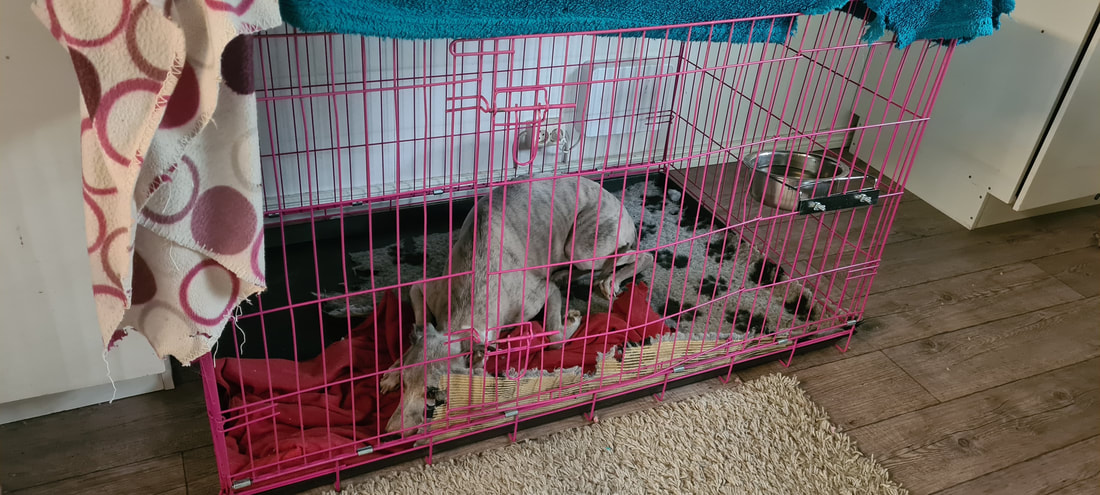 Haikalanen on koiristani ehdottomasti häkkimyönteisin. Silloin tällöin olen löytänyt sen häkistä näin ja olen hetkellisesti surkutellut, että onkohan se vahingossa lukinnut itsensä häkkiin eikä tajunnut, että ovea työntämällä se pääsisi ulos. Testasin kuitenkin asiaa yksi päivä kutsumalla sitä luokseni ja se tottuneesti työnsi oven auki nenällään sen suurempia ihmettelemättä. Niinpä oletan, että se ymmärtää pääsevänsä halutessaan ulos. Se vain valitsee nukkua häkissä, koska siellä on omaa rauhaa ja turvallista. Kuten monet, myös minä halusin nuorempana väellä ja väkisin tehdä kaikesta hankalaa. Tuli tärkeä olo, kun koki tekevänsä vaikeita juttuja ja omistavansa hankalia koiria. Kuitenkin, omistaessani oikeasti vaativia koiria nyt, voin naureskella nuorelle itselleni ja sille raivokkaalle tarmolle, jolla yritin selitellä itselleni poikiani haastavammaksi kuin mitä ne olivat. Kyllä, Kenraalimajuri oli ja on vieläkin haastava koira hermorakenteensa puolesta, mutta noin muuten ei ollenkaan. Haikalanen on aina ollut ihastuttavan rentouttava elämänkumppani. Varsinkin nuorilla koiraharrastajilla on tapana tehdä asioista välillä turhan hankalia. Syyllistyin tähän itsekin, joten voin näin vuosia myöhemmin myöntää sen ja myös todeta näkeväni sitä toisissa. Koiranomistaminen on kilpavarustelua ja haastavan koiran kasvattamisesta voi lisätä sulan mentaaliseen hattuunsa. Niinpä koiraharrastajilla on tapana glorifioida vaikeutta ja hankaluutta ja tehdä ongelmia sinne, missä niitä ei todellisuudessa ole. Tämä on osaltaan tottumattomuutta, osaltaan antaa luvan olla silloin tällöin väsynyt ja lannistunut. Meidän tulisi olla armeliaampia itsellemme ja ymmärtää, että helponkin koiran kanssa on välillä vähän raskasta. Joskus on lupa todeta, että se vähäkin on tänään liikaa ja istua koko päivä katsomassa telkkaria ja syömässä lohturuokaa, kunhan koiran perustarpeista huolehditaan ja lusmuilu ei tule tavaksi. Haastavuuden ihannointi johtaa helposti siihen, että hankitaan liian vaikeita koiria. Tämä voi osaltaan kannustaa käyttämään kyseenalaisia koulutusmetodeita, kun oma taitotaso ei yksinkertaisesti riitä. Helposti käy myös niin, ettei niistä mutkattomista arjen kavereista ja niiden kouluttamisesta tajua ottaa itselleen krediittiä, vaikka ehdottomasti pitäisi! Oli koira miten mutkaton tahansa, jokainen hyvin käyttäytyvä koira on kouluttaneelle syystäkin ilon, onnen ja ylpeyden aihe. Myös sillä helpolla koiralla voi olla tai sille voi kehittyä ongelma, ja se taas ei tarkoita automaattisesti sitä, että kouluttaja on surkimus. Takana voi olla vaikkapa trauma. Hyvin käyttäytyvästä koirasta saa ja siitä pitää olla ylpeä, oli sen rotu mikä tahansa. Vaivaton, helposti arjen rutiinit ja tavat oppiva koira tulisi nostaa arvostuksessa korkeammalle kuin missä se on nyt. Sen kanssa pääsee nopeasti nauttimaan siitä, mitä koiranomistaminen on parhaimmillaan! Sujuvaa ja stressitöntäHaikalasen kanssa lenkkeily on sitä, mitä koiran kanssa ulkoileminen voi parhaimmillaan olla. Joskus Haikalanen voi pelästyä vastaantulevia, mutta jos tilanteet ennakoi ja pysyy itse rauhallisena, myös Haikalanen selviää ohituksesta nopeasti. Se ei vedä, muttei jumita. Se menee tasaista tahtia hihnanmitan edellä, kiskomatta, nuuhkii silloin tällöin ja tekee asiansa, muttei jää patsastelemaan. Sen kanssa voi uppoutua ihailemaan kevääseen heräävää luontoa tai tarkkailla pikkulintuja pajupusikossa. Sen kanssa voi pällistellä puroja ja hienoja kiviä ja maisemia, tai sen kanssa voi hölkätä rivakasti eteenpäin kunnonkohotusmielessä. Haikalanen ottaa kaikki ihmiset vastaan iloisesti. Se ei arkaile, ei ole vihainen, ei käyttäydy arvaamattomasti. Se ei tee itsestään numeroa vieraiden aikana, mutta tulee iloisena rapsuteltavaksi. Haikalanen on arjessa ihastuttavan mutkaton koira. Lumiprinsessa ja Sotaperuna ovat vaativia. Sotaperunan voimakas aggressio aiheuttaa erityisjärjestelyitä arkeen ja vaatii ahkeraa koulutusta ja treeniä pysyäkseen hallinnassa. Sillä on korkea energiataso ja se haluaa ja myös vaatii fyysistä ja psyykkistä haastamista. Lumiprinsessalla ei ole aggressiota, mutta se on aktiivinen ja touhukas koira, joka varsinkin nuorena tarvitsi roppakaupalla tekemistä ollakseen sisätiloissa ja lepohetkinä hallinnassa. Vaativan koiran kanssa pääsee haastamaan itsensä ja kehittyy kouluttajana. Monesti hyvä harrastuskoira on myös arjessa vaativampi kuin lupsakampi ja rennompi kaverinsa. Vaativan koiran kanssa voi arjestaan saada sujuvaa, mutta se ollatenkin VAATII vaivannäköä. Tästä syystä tulisikin aina kysyä itseltään, onko sille vaivannäölle aikaa? Onko siihen halua? Mukava, mutkaton rotu/koirayksilö antaa aivan yhtä paljon, mutta huomattavasti vähemmällä säätämisellä. Jos ei ole tahtoa eikä tarvetta nähdä vaivaa ja tehdä töitä, kannattaa koira valita se mielessä pitäen. Jokaiselle omansaVaikkei mikään koira ole vaivaton eikä helppo sellaiselle, joka ei koiran kanssa halua elää, vihkiytyneelle koiraihmiselle löytyy roppakaupalla suhteellisen helposti koulutettavia rotu/koiravaihtoehtoja. On paljolti myös asenteesta kiinni, minkä näkee ongelmana. Nuoren uroskoiran törttöilyt kuuluvat yksilöstä ja perimästä riippumatta usein asiaan. Ei niistä kannata vääntää ongelmaa. Ne ovat täysin tyypillisiä nuoren uroskoiran sähläyksiä, joihin kannattaa suhtautua nimenomaan sellaisina eikä vaipua ahdistuksen ja ankeuden suohon ja vakuutella itselleen oman koiransa haastavuutta. Ongelmia ei kannata tehdä sinne, missä niitä ei ole. Se lisää stressiä sekä omistajalla että koiralla. Tulisuuden ja särmän vaaliminen on tärkeää silloin, kun koiran tyypillisesti tulee tällaisia piirteitä syystä tai toisesta ilmentää. Tällaisten piirteiden ihannoiminen ja niiden hakeminen silloin, kun etsinnässä on lupsakka ja helppo arjen seuralainen, on täysin turhaa. Myös maltillisella energiatasolla varustettu koira voi olla luonteikas arjen kaveri ja myös sen kanssa voi vaeltaa kilometritolkulla toreilla ja tuntureilla. Siihen tarkoitukseen ei kannata väellä ja väkisin etsiä sitä koiraa, jolla energiaa on kahmalokaupalla, jolla on voimakkaat vietit ja joka rotutyypillisesti suhtautuu asioihin varauksella. Arjessa helpolla ja mutkattomalla koiralla on sielua parantava vaikutus. Sitä ei tulisi koskaan väheksyä. Haastavakin koira parantaa toki sielua sellaisella ihmisellä, jolla on tarjota sen vaatimuksille sopiva koti. Meidän kannattaakin kysyä itseltämme, mitä me haemme, ja valita seuraksemme koira, joka hakee samaa. The saying ”two is a pair, three is a pack” is used sometimes to describe the difference between owning one or two individual dogs and owning three or more dogs that already start to have certain pack behavior. Obviously all dogs interact together the same way, whether they live live alone or in a group, but pack behavior usually kicks in when there are more than two dogs. Pack behavior refers to behavioral patterns that are usually met in large groups of dogs. These patterns take act in situations like meeting others dogs, hunting, facing danger or alarming. It is said that a pack of dogs let loose, even if they are pet dogs, is more dangerous than a pair of dogs or just one dog. In Finland we have a saying ”joukossa tyhmyys tiivistyy”. It means you are never as stupid alone than you are in a group. Group members easily adopt behavior from others in the group, and this leads to certain behaviors becoming easily escalated. If one member of the pack is nervous, that feeling reflects to others more easily than it would if there would be just two dogs. Aggression escalates quickly, and so does the hunting behavior. It takes one of the pack to start hunting, and the rest will follow. This leads to problems if the dogs are loose and they decide instead of playing with a small dog they will now HUNT the small dog. Same happens if the pack escapes and ends up harassing lambs or other farm animals, or even people. Dogs that live in a pack form a hierarchy based on each individual and their character. No matter certain roles may change depending on the situation, it is interesting to see how each member of the pack will usually follow the role it was set to have and in many cases even chose itself. Genders have different roles in the pack, and age plays a bigger part in interactions. Balanced leaders will act firm and friendly, while those lower in the hierarchy often clown around and get away with such ridiculous behavior more easily than the ones leaders may seem as ”possible future challengers”. Alarming is one interesting feature I noticed changed significantly when I had a pack. Instead of one or two dogs each barking, a pack now seems to have different roles. When one dog alarms, others will instantly run to the one alarming and try to see the threat. The leader will then decide whether or not the threat is worth noticing. If so, it will take a dominant posture, hold it’s tail up and stare, approaching the threat if it can, while others keep alert, keep barking and follow the leader. If the leader at any point relaxes, others will eventually follow or their attitude will change from nervous and aggressive to curious, playful or indifferent. Lowest in hierarchy might even stay away from the situation, because it trusts the ”higher ups” will care for everything. When having a pack of dogs, it’s important to focus on leading the pack rather than trying to lead every individual dog. This means you need to know what causes certain behavior, and if you need to command the leading dog or leave that dog be and instead find the ”weak link” that feeds negative behavior of the whole pack. Correcting or controlling the alarming dog will not do anything, if the leading dog keeps on signaling we need to stay alert. On the contrary, if one dog is nervous about a situation, working with that individual dog will solve the whole problem while trying to calm the whole pack down each time it gets nervous makes no difference. In a pack one dog’s behavioral issue is EVERY DOG’S behavioral issue. Introducing a new family memberBringing a new dog to the pack can be frightening. What if the dogs don’t accept each other? Let’s say it here in the beginning; it is a possibility. However, you can work with issues, and in most cases that helps. In some other cases you might have to separate the dogs in one way, at least partially and at least sometimes, but even that is not the end of the world. Usually things go smoothly, and sooner or later your new dog will be part of the pack or form a good working pair with the first one.
Know your previous dog/dogs. If you have a nervous dog or an unsocial dog, introducing the newcomer in small steps is usually the best option. Ideal would be to meet the new dog a couple of times before it moves in. Collect all ”treasures” away. Very important objects might not be up for sharing just yet. After all, your dogs just met. Going for a walk together and introducing the dogs on a neutral ground works better than bringing the pup/the dog straight to the other one’s territory. A possibility to give the new dog a safe, calm place to sleep it’s first nights is also beneficial. If others are constantly trying to get to know it, it might stress both them and the new one (and vice versa, if the newcomer doesn’t leave the old dog alone). What if problems occur?Don’t let the old dog jump on the eyes of the newcomer, and don’t let the newcomer boss around the old dog. You are the authority making sure everyone feels safe and sound. Old fashioned ”leadership tricks” like rolling the dog on it’s back work only with soft dogs, and they are not based in any scientific or species related information. In the case of independent dogs and dominant dogs things like this can make the situation worse or the dog may even turn on you. The most important thing, however, is that nothing is taught this way. The effect is based on fear, not respect, and it works only with you and the dog, not to improve the situation between dogs. This is seen in many cases where people use rolling the dog on it’s back, for example, to correct it’s dominant behavior. The dog may then act OK with the human, but still bully in the pack. Nothing was taught, the problem and the source for the behavior still remains. One visible side effect was removed, that’s it. The right way to deal with possible friction between the dogs is to teach and encourage the right kind of pack behavior and to correct the dog behaving badly. How do you correct a dog like that? Well certainly not rolling it on it’s back. Physical corrections should always be used to either get the attention of the dog so you can command it to leave, stay or calm down, or to restrain the dog from harming or harassing another living being. Teaching the right kind of behavior is as important as stopping the unwanted behavior. The problem with ”The Leadership Theory” is that is doesn’t teach the dog anything, it focuses on stopping certain behavioral patterns. Smart dogs might get what you are trying to say, while nervous, aloof, dominant and temperamental dogs usually don’t. Positive reinforcement and working with the dog’s aggression and insecurities usually lead to a dog that can to certain point work and live in a pack, while some dogs never become pack animals. Keep your head cool. ”Be the boss of your dogs and all goes well!” is something you will hear if your dogs are not friends at once. While there is half the truth in that, be careful with how you acquire that position of authority, and remember; weak nerve structure will cause problems whether or not you are ”a boss”. Not all dogs are balanced, and aggressive dogs are aggressive dogs. It is dangerous to assume everything depends on how you raise the dog or socialize it. Always go for mentally balanced dogs, or then be prepared to work with those that have more complicated nerve structure. Don't be too afraid to add another dog to your pack. Knowing your current dogs and your own resources is the key to success. Another thing to ease a troubled mind; most dogs are pack animals. They might not be super social, but most get along at least with the member of opposite gender. For the majority of dogs having another dog in the family is the funniest, most awesome thing they have ever had happening. After all, we are ONLY human. There are some things only other dogs get, ya know.
Socializing your puppy is probably the most important thing you can do. Many of new puppy owners will focus on simple tricks such as sit, stay, down when they get their puppy, and it is very true that it's easy to train a small puppy. The most important thing to focus in, however, is making the dog familiar with this surrounding world we live in and all the weird stuff it is supposed to tolerate without stress when it gets younger.Breeders should do the basic sozialicing before the pups even leafe their mother's side. Getting the pups outside to smell fresh air (if the weather and temperature allows it) and getting them used to different surfaces is very important when raising a litter of pups. Meeting people before moving to one's own family is also important. If the family has other, vaccinated, familiar dogs living in the house, meeting and playing with them is also very beneficial to the pup. The thing to remember by the new owner is that no matter how much the breeder does work with the pups, the main work is left to the new home. The timing is also crucial, since from 3 weeks old to 12 weeks old is the phase the pup is most open to new things. It is called the socialization stage, and meeting as many people as possible and going to as many safe places as possible is the most effective at this stage. After this the pup will become a little less open to new things and warming up slows down. It may also start to have surrealistic fears, which is perfectly normal but may make meeting new people and getting accustomed to new places less effective and more stressful. The fear stage will pass eventually, but if one skips the early socialization and waits until the fear stage is over one misses the most sensitive weeks of learning in the beginning. That may have later negative effects on how the dog sees the world. How to develop social skills of your puppyPups don't get their perfect vaccinations until 12 weeks or after. This means the pup is not welcome to most dog happenings and you should also be wary with meeting strange dogs in general. However, meeting familiar, friendly dogs you know are vaccinated and taken care of is not only possible but also adviced. This way the pup learns how to behave with other dogs. It has learned basics of this in a litter box with it's mother and siblings and possible other dogs of the breeder's family, but developing these skills with new safe friends is always beneficial. Be sure that the dogs the pup meets are friendly. The time of getting to tolerate unfriendly dogs is not at this point. The pup needs to meet balanced dogs, so they can show balanced way of behaving. Meeting new people is crucial too. Some breeds are more aloof than others, some pups are friendly from the start. Mixing shyness with aloofness is very common. A shy dog shows excessive amount of calming signals and stress when it meets new people. Aloof pup just simply ignores the new people or monitors them from afar at first. Wary dogs don't want to come near new persons in the beginning and may show signs of, well, being wary when they approach them, but this passes eventually as the pup learns these people are of no threat. No matter there is a clear difference between being aloof and wary and being shy and having bad nerves, it is a fact that wary, aloof breeds are more prone to become nervous, shy and unsocial if they lack sozialication. This is why one needs to put some extra work in sozialication if one takes in some of these breeds or dogs. Taking the pup to experience different types of surfaces or at least making sure it gets to know them at home will pay back later when the pup needs to walk calmly in concrete, grass, steel, asfalt, stone, sand. One can also train the pups ability to ignore moving surfaces by building small unstable platforms that are safe for the pup to investigate. Some pups go on these platforms themselves, some might need encouraging, but a small pup is easy to train if it's nerves are good. If they are not, it takes more time and effort to train the dog and one needs to be careful not to pressure the pup too much. This can also happen with strong, brave pups, but they can take more than their nervous counterparts. The last thing to think is if there is a mall or some sort of a market place filled with people you can take your pup to. Make sure you have good leash and harness/collar, and make sure not to leave your pup too alone. Don't protect it too much, either. Carrying it around in your lap the whole time doesn't really teach it to face this environment by itself. Getting to see these loud, crowded places is essential for example hobby, working and show dogs who are supposed to be able to relax in these environments when they are older. It is beneficial for the others, too. Tolerating varietyDogs are slaves of the routine, and if adult certain color people of certain sex are the most they meet, they can act stressed and wary, even scared among other kinds of people. Dogs don't understand our social norms and what is considered polite and what is not. They will bark at disabled people, people that talk differently, people that are of different color they are used to, kids, elders, if they are not taken to meet them and be properly socialized. One common mistake to do when raising a pup is bad socialization. Many people don't understand just how much it may take to make your dog experience new places and people and other dogs without fear and stress. This doesn't mean going to the market once or playing with neighbor's kids. This means meeting as many different people in as many different places as one just possibly can without putting too much stress on the puppy. After all, we live in a very odd world in the eyes of the dog. Many of the things we expect from our dogs is against their nature, and therefore we must train and help them to understand what we expect of them.
Also remember that tolerating is not the same thing as liking. Your dog doesn't need to like kids any more than you do, but neither of you can go snapping at kids just because they are kids. You can teach your dog to take space and go away when it is bored and tired of children, and as an owner you must then make sure the children, in return, let your dog be alone.
Mr. Hyperactivity and Ms. Dominance love children and they are very eager to play with them, poke them, sniff them and lick them. Mrs. Aloofness could care less, Mr. Arthritis doesn't really prefer kids either. Both of the latter know how to take their own space when they get tired. Mr. Arthritis may sometimes forget that, since his is a nervous, stressed character, and in that case I as his owner have to tell him to leave, go somewhere to lay and calm down. Stress is a poor excuse that he would go around snapping at children. That is not to be tolerated and I need to make sure he is of no threat. In return, if you are a parent, teach your children to leave strange dogs alone and respect dog's own space. The most unnatural situation for dogs and kids alike is when the dog is tied for example in front of a shop, it is alone, and unfamiliar kids go to pet it. In this situation the dog, even the one that knows how to give space, doesn't have any means to escape. Things can escalate, and therefore teach your children to stay away from strange dogs and always ask permission to near them. Also don't tie your dogs in front of shops alone. Positive training methods have been widely adopted by many trainers around the world in the past years. This is partly because pets have gained a more important role in families and the demand of humane training methods is growing, but also because newest studies show positive methods have a striking effect on how fast and how eager the dog, or the human for that matter, is to learn. |
Mistä on kyse?Koko elämänsä koiria harrastaneen raakaruokintafriikin ajatuksia, pohdintoja ja elämää koiralauman kanssa. Seuraa meitä
Päivitämme säännöllisen epäsäännöllisesti myös Facebookiin.
Historia
June 2022
Kategoriat
All
|

